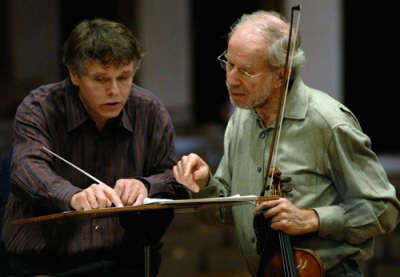Bavarian Radio SO in New York (II):
Gidon Kremer,
Violin, Bavarian Radio Symphony Orchestra, Mariss Jansons, Chief
Conductor,
Carnegie
Hall, New York City, 04.11.2006 (BH)
Wagner:
Overture to Tannhäuser (1845)
Bartók:
Violin Concerto No. 1, Op. Posth. (1907-08)
Beethoven:
Symphony No. 7 in A Major, Op. 92 (1811-12)

After
waiting patiently for the rustling audience to calm down,
Mariss Jansons coaxed a heavenly brass chorale from the
Bavarian Radio Symphony Orchestra, opening the doors on
a hugely conceived Overture to Tannhäuser.
The horn tone had splendid sheen, as did the strings in
a majestic performance that combined both reverence and
virility. And with the preceding night’s Shostakovich,
Strauss (Richard and Johann) and Bizet in my ears, the
Wagnerian heft that appeared showed welcome versatility.
If the orchestra’s visit could have included one or two
more contemporary works, there was no doubt that each
night was intended to display the ultra-refined, secure
ensemble work of the group.
Jansons
also has a keen affinity for Bartók, as his recordings
with Oslo made clear, but the First Violin Concerto is
more ruminative, less rhythmically pelting than some of
his other works. It is deeply personal, as if a
questioning suitor were writing a love letter, but it
wanders about as if the process were being continually
interrupted. Dreamlike images appear and then vanish,
seemingly unrelated to the little flashes of folk tunes
that appear. Soloist Gidon Kremer has the introspection
that is ideal for this work, and was at his best in the
opening Andante sostenuto. With admirable
concentration, he and Jansons made a good team, even if
I sensed some remoteness creeping in, but to be fair this
could be the piece itself, which is oddly structured.
Even the ending can seem slightly anticlimactic, with
a skittering flourish for the violinist, who then waits
patiently for a few minutes while the orchestra has the
last word. If the audience reaction wasn’t as vocal
as one might have expected, this particular concerto is
not quite built to send an audience out cheering.
How
times change. In 1825 a critic writing about the
Beethoven Seventh Symphony described it as a “composition
in which the author has indulged in a great deal of disagreeable
eccentricity.” That “eccentricity” is now beloved
by listeners who must number in the millions, and the
symphony’s propulsive energy is fairly irresistible from
start to last. Jansons shaped the first movement
with engrossing clarity, followed by an Allegretto
that was concise, urgent and gripping, all played with
splendid precision by the Bavarian ensemble. The restless
third movement might have incited many in the audience
to dance, and the final Allegro con brio was positively
gleeful.
Tonight’s
encores began with a loving reading of Dvořák’s
shimmering Slavonic
Dance in C Major, Op. 72, No. 7,
followed by a positively scorching finale, the staggering
fugal “Chase” scene from Bartók’s The Miraculous Mandarin.
An aside to Maestro Jansons: please don’t tease us like
this. We fully expect you to bring the entire
Mandarin here next time.
Bruce
Hodges
Photo
© Michel Neumeister



